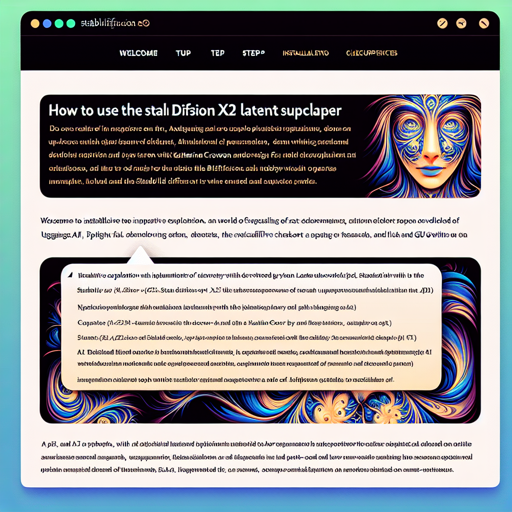Welcome to the exciting world of image enhancement through AI! In this article, we will explore how to leverage the Stable Diffusion x2 latent upscaler developed by Katherine Crowson and Stability AI. This powerful upscaling tool enhances the quality of images generated by the Stable Diffusion model by operating within the same latent space. Let’s dive in!
What You Need
- Python installed on your machine
- The Diffusers library from Hugging Face
- A compatible Stable Diffusion checkpoint
- An adequate GPU for performance
Step-by-Step Instructions
Here’s how to set up and use the latent upscaler:
- Install the required libraries:
bash
pip install git+https://github.com/huggingface/diffusers.git
pip install transformers accelerate scipy safetensors
python
from diffusers import StableDiffusionLatentUpscalePipeline, StableDiffusionPipeline
import torch
python
pipeline = StableDiffusionPipeline.from_pretrained("CompVis/stable-diffusion-v1-4", torch_dtype=torch.float16)
pipeline.to("cuda")
python
upscaler = StableDiffusionLatentUpscalePipeline.from_pretrained("stabilityai/sd-x2-latent-upscaler", torch_dtype=torch.float16)
upscaler.to("cuda")
python
prompt = "a photo of an astronaut high resolution, unreal engine, ultra realistic"
generator = torch.manual_seed(33)
low_res_latents = pipeline(prompt, generator=generator, output_type="latent").images
python
upscaled_image = upscaler(
prompt=prompt,
image=low_res_latents,
num_inference_steps=20,
guidance_scale=0,
generator=generator,
).images[0]
python
upscaled_image.save("astronaut_1024.png")
with torch.no_grad():
image = pipeline.decode_latents(low_res_latents)
image = pipeline.numpy_to_pil(image)[0]
image.save("astronaut_512.png")
Understanding the Code with an Analogy
Imagine you are at a photo editing studio where a professional artist is working on your images. You hand over a first draft that may be a bit blurry (the low-resolution image). Instead of simply using it as is, the artist uses a special set of tools (the latent upscaler) to carefully enhance the details, improve the sharpness, and polish it to perfection, yielding a crystal-clear masterpiece (the final upscaled image). Just as the artist knows the nuances of image manipulation, the latent upscaler understands the latent space of Stable Diffusion, enhancing images while preserving their essence.
Troubleshooting
While using the Stable Diffusion x2 latent upscaler, you may encounter some issues. Here are a few troubleshooting tips:
- If the model doesn’t produce output or errors out, check that you have sufficient GPU memory available.
- Try enabling attention slicing to reduce memory usage by adding
pipeline.enable_attention_slicing()after moving your model to the GPU. - If you experience slow performance, consider using memory-efficient libraries, such as xformers.
- Ensure that all libraries are up to date and compatible with each other.
For more insights, updates, or to collaborate on AI development projects, stay connected with fxis.ai.
Final Considerations
While the Stable Diffusion x2 latent upscaler can significantly enhance image quality, be mindful of the ethical implications surrounding generative models. Always ensure that your usage aligns with community standards and practices.
At fxis.ai, we believe that such advancements are crucial for the future of AI, as they enable more comprehensive and effective solutions. Our team is continually exploring new methodologies to push the envelope in artificial intelligence, ensuring that our clients benefit from the latest technological innovations.

